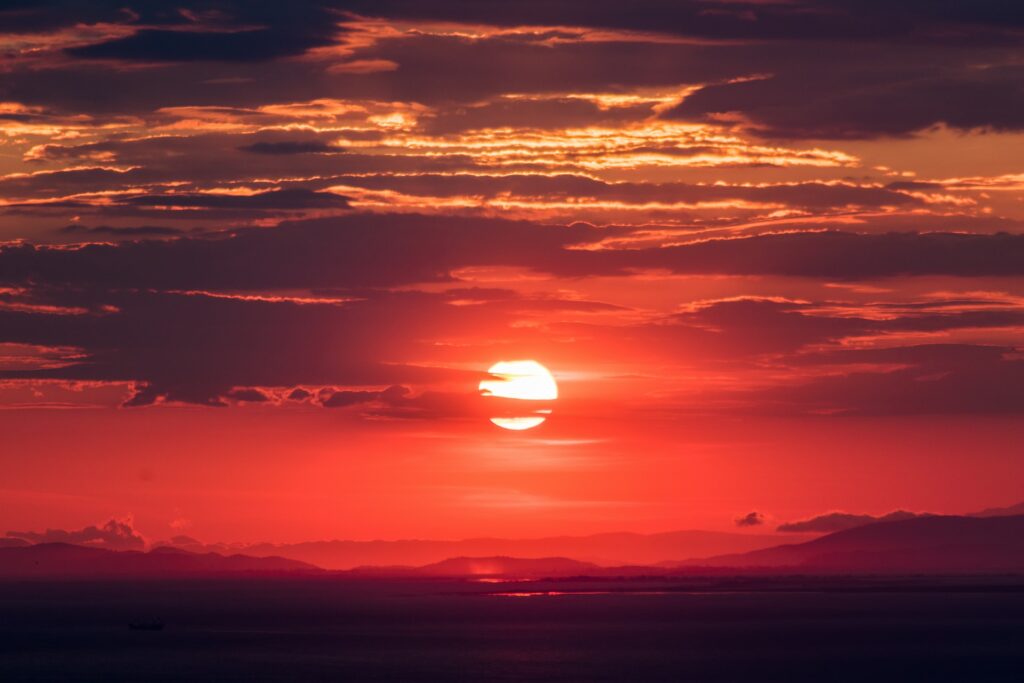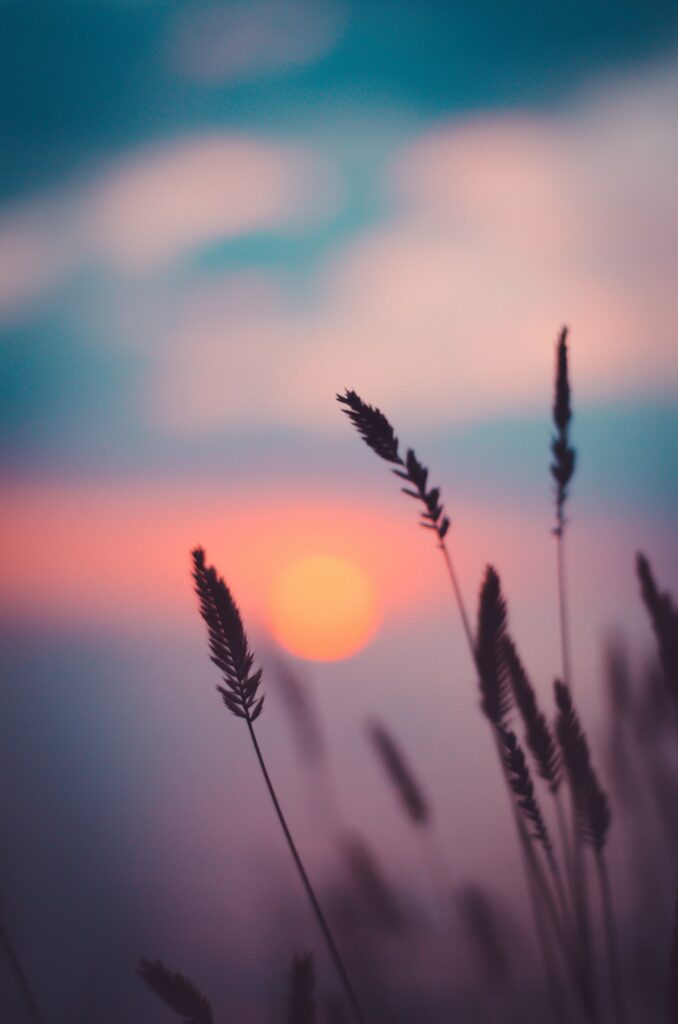Sunset Photography Ideas is something lots of people are looking for to increase the potential of their pictures, like new areas, new angles, and new places to explore and take pictures of, If any of these topics are of interest to you, then keep reading.
Sunrise or sunset, both times of the day are below the golden hour. When the sun rises or sets, the Star King does his best with light and color. It creates special, evocative, and exciting effects. At sunset, the light is more intense and the colors blend with the landscape, leaving everyone in awe as they stand in front of this natural wonder.

Sunset Photography Ideas: Technical Details
For sunset photography, the ideal is to use a wide angle to capture the width you need. You can use a prime lens or an “all terrain” lens using the shortest focal length.
It’s also important to use relatively large f-numbers, starting at f/14, so that the entire frame is in sharp focus. The relatively small aperture and low ambient light will force you to choose a longer exposure time.
In fact, if you want colors to look soft in your sunset photography ideas, it’s a good idea to use an ND filter of 4 or higher to darken the scene enough to leave the shutter open for 20 seconds or more.
Due to the long exposure it requires, the use of a tripod is essential if you do not want the images to come out blurry. It’s also important to use a remote shutter release or camera timer if you don’t have one.
In these conditions, it is not necessary to use high sensitivity values because the camera’s sensor will be exposed long enough to capture the correct amount of light, so there is no need to increase sensitivity. At ISO 100, it’s perfectly possible to get a great sunset or sunrise shot.
Searching For the Right Time
Sunsets are one of the most popular subjects in photography. Sunset photography ideas are very interesting. Even after the sun has dipped below the horizon, the glow that lights up the sky for around 20 minutes can create truly beautiful effects. Try these sunset photography ideas to make the most of these magical moments.
A good way to tell if a sunset is spectacular is to look at the clouds. High, irregular clouds with plenty of space between them are ideal, as each cloud receives a bit of light and color, creating a visually appealing scene. Cloud masses are not a good sign.
Another sign that the sunset will be fun, is usually a rainy day. If the sky starts to clear around sunset, you may be able to get some great photos.
All sunset shots require you to move quickly. You may have 20 minutes to get a good result, and the image can completely change in a matter of minutes depending on how the light intensity changes, and how it reflects off different objects. It’s important to set this up ahead of time so you don’t waste time setting up the tripod or miss the best moments.
An important point is that the exposure measurement method must be “SPOT”. Because of the Matrix readings (unless you’re shooting the sun in the background), you risk a burned image. With SPOT mode, you can take readings and measure light in various areas; remembering not to aim directly at the sun, but around it.
Details To Take into Account: There Is Not Only the Sun
Creating a beautiful and interesting photo of a sunset usually requires more than just the sunset: for example, foreground subjects in the frame, such as shapes, shadows, details, or textures; Similarly, clouds and birds in the sky can help add depth, interest, and vibrancy to sunset photography ideas.
Exposure times longer than one second (when the sun has dipped below the horizon) are often used, so camera shake should be avoided as much as possible; use a tripod and cable release, or a camera timer for this.
You’ll find that as the light fades, you need faster and faster shutter speeds. Constantly review the image, and histogram on the screen, and, if necessary, increase the exposure time of the next image.
But if you want sharp detail of the silhouette in the foreground, you should increase the shutter speed; but keep in mind that if the silhouette is too detailed, darkness will take over the image.
While the sun is shining in the sky, set the aperture priority (the camera’s A-mode) or auto-ISO if you’re shooting handheld so that the camera has a balanced exposure when the light from the sky fades.
Light changes very quickly at dusk, and using manual (M) mode means you’re constantly adjusting your camera settings to maintain a good exposure without taking the time to assess the lighting and composition of the scene.
If you need a slower shutter speed, use a neutral density filter, or choose a smaller aperture like f/11 or f/16. A low ISO of 64 or 100 also results in higher image quality and a slower shutter speed.
Sunset Photography Ideas: The Final Part of Twilight
During twilight or blue hour, and after the sun has set, if you’re still shooting in aperture priority mode, you can use the camera’s exposure compensation feature to adjust the exposure to make sure it’s set on the right amount of exposure.
Or, if you want full control over exposure, you can switch to Manual (M) mode for better control over shutter speed and aperture settings. You can choose between automatic or manual focus to ensure sharp, clear photos in low light.
If you select autofocus and use the center focus point in low light, you will be able to focus faster.
If you still can’t find the focus you want and find it difficult, switch to manual focus on the camera lens and body; activate Live View mode, and then use the touch screen or plus button to zoom in on the LCD screen. Finally, rotate the lens on the manual focus ring until the subject is in focus.
A third option is to pre-focus the lens on your subject while there is still light and lock the focus.
Pay attention to the metering if you want the light to be visible in twilight scenes, such as building lights or burning streetlights. Low light can trick the exposure meter, and it’s possible to set a slower shutter speed to brighten the darker parts of the scene, but this will overexpose and burn out the highlights.
Use exposure compensation to prevent this from happening. If most of the scene is dark, you may need to underexpose several times. Also, a slight underexposure in the sunset scene lightens the colors a bit.

Paying Attention to All the Details Is the Secret
Make sure the settings are correct by checking the image on the LCD screen and the histogram. A histogram is a graphical representation of the tonal range of a photo and is a snapshot analysis of the image you just took.
When you take a sunset picture, it instantly shows you if there’s overexposure or reflections. Look for distortion in the highlighted areas: sharp points in high concentration on the right side of the histogram.
Some highlights may be distorted if the sun is in the image, but in many cases this won’t matter if most of the histogram curve is roughly in the center of the graph.
Many of these sunset photography ideas are also useful for filming sunsets.
If you’re shooting directly into the sunset, don’t let the lens flare wash out the detail. This can be done by darkening the scene by choosing a smaller aperture to let in less light.
You can also use a polarizing filter to block excess light or a diffuse filter to disperse it.
Another option is not to photograph the sun and focus on the landscape illuminated by the last sun rays; this also applies to still images. For more options when editing, try to capture as many of these two types of scenes as possible while the light is still clear.
Sunset Photography Ideas: Quick Tips from The Pros
Always shoot in RAW (NEF) files so you can capture as much information as possible in your images for post-processing.
Choose daylight or shade-white balance to capture deep blue twilight skies and warm yellow-orange lighting. If you shoot in RAW, you can fix any white balance issues later on your computer.
Sunset photography ideas with flash may seem too obvious, but you can achieve a more natural effect by putting a tungsten or heat filter on your flash. Use a graduated neutral density (ND) filter in the horizontal adjustment step to balance the contrast between the lighter evening sky and the darker foreground.
Since you’re not a night owl, try to photograph sunsets in the fall and winter, when the days get shorter.
Cristian Valles is a Miami-based professional photographer. With 14 years of experience in studio and outdoor photography, you can be sure to get the best sunset shots to capture that wonderful time of the day. Visit Cristian Valles Films to view his work, find information about his services, or schedule an appointment.


